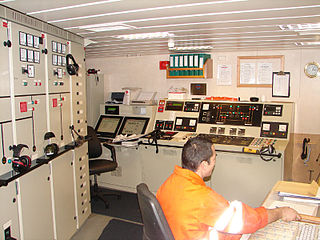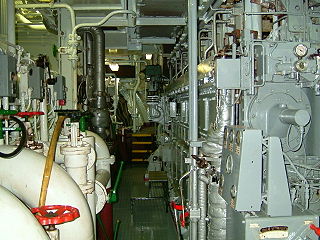
An engine department or engineering department is an organizational unit aboard a ship that is responsible for the operation, maintenance, and repair of the propulsion systems and the support systems for crew, passengers, and cargo. These include the ship engine, fuel oil, lubrication, water distillation, separation process, lighting, air conditioning, and refrigeration.

Heating, ventilation, and air conditioning (HVAC) is the use of various technologies to control the temperature, humidity, and purity of the air in an enclosed space. Its goal is to provide thermal comfort and acceptable indoor air quality. HVAC system design is a subdiscipline of mechanical engineering, based on the principles of thermodynamics, fluid mechanics, and heat transfer. "Refrigeration" is sometimes added to the field's abbreviation as HVAC&R or HVACR, or "ventilation" is dropped, as in HACR.

On a ship, the engine room (ER) is the compartment where the machinery for marine propulsion is located. The engine room is generally the largest physical compartment of the machinery space. It houses the vessel's prime mover, usually some variations of a heat engine. On some ships, there may be more than one engine room, such as forward and aft, or port or starboard engine rooms, or may be simply numbered. To increase a vessel's safety and chances of surviving damage, the machinery necessary for the ship's operation may be segregated into various spaces.
The Royal Naval Engineers is the branch of the Royal Navy responsible for engineering, as a branch they have existed since 1835.
Seafaring is a tradition that encompasses a variety of professions and ranks. Each of these roles carries unique responsibilities that are integral to the successful operation of a seafaring vessel. A ship's crew can generally be divided into four main categories: the deck department, the engineering department, the steward's department, and other. The reasoning behind this is that a ship's bridge, filled with sophisticated navigational equipment, requires skills differing from those used on deck operations – such as berthing, cargo and/or military devices – which in turn requires skills different from those used in a ship's engine room and propulsion, and so on.

Machinist's mate is a rating in the United States Navy's engineering community.

Marine engineering is the engineering of boats, ships, submarines, and any other marine vessel. Here it is also taken to include the engineering of other ocean systems and structures – referred to in certain academic and professional circles as “ocean engineering.”
A fourth engineer or third assistant engineer is the most Junior engine officer in the engine department of a merchant vessel.
A third engineer or second assistant engineer is a rank of engine officer who is part of the engine department on a ship.
A second engineer or first assistant engineer is a licensed member of the engineering department on a merchant vessel. This title is used for the person on a ship responsible for supervising the daily maintenance and operation of the engine department. They report directly to the chief engineer.

An oiler is a worker whose main job is to oil machinery. In previous eras there were oiler positions in various industries, including maritime work, railroading, steelmaking, and mining. Today most such positions have been eliminated through technological change; lubrication tends to require less human intervention, so that workers seldom have oiling as a principal duty. In the days of ubiquitous plain bearings, oiling was often a job description in and of itself.

Engineman is a United States Navy occupational rating. Engineman was the former name for the current U.S. Coast Guard rating of Machinery Technician.

A stationary engineer is a technically trained professional who operates, troubleshoots and oversees industrial machinery and equipment that provide and utilize energy in various forms.

Machinery Technician (MK) is an enlisted rating in the United States Coast Guard that is responsible for the operation, maintenance and repair of a cutter's propulsion, auxiliary equipment and outside equipment, internal combustion engines, environmental support systems, hydraulics, generator sets, and areas of hazardous material recovery and control. They are also responsible for the engineering maintenance of any small boats assigned to their command. At smaller stations and cutters they also serve as electricians.
The United States Navy Nuclear Propulsion community consists of Naval Officers and Enlisted members who are specially trained to run and maintain the nuclear reactors that power the submarines and aircraft carriers of the United States Navy. Operating more than 80 nuclear-powered ships, the United States Navy is currently the largest naval force in the world.

On a ship, the fire room, or FR or boiler room or stokehold, referred to the space, or spaces, of a vessel where water was brought to a boil. The steam was then transmitted to a separate engine room, often located immediately aft, where it was utilized to power the vessel. To increase the safety and damage survivability of a vessel, the machinery necessary for operations may be segregated into various spaces, the fire room was one of these spaces, and was among the largest physical compartment of the machinery space. On some ships, the space comprised more than one fire room, such as forward and aft, or port or starboard fire rooms, or may be simply numbered. Each room was connected to a flue, exhausting into a stack ventilating smoke.

Engine room artificer (ERA) is a specialised position in the crews of naval vessels – especially those of the British Royal Navy (RN) and other Commonwealth navies. An ERA is usually a fitter and turner, boilermaker, coppersmith or enginesmith. On larger vessels, there are several ERAs, divided into three or more classes. Each of these positions is normally associated with a specific non-commissioned rank and level of experience – for example, an ERA is normally a Chief Petty Officer (CPO). The designation ERA was introduced in the early days of steam-powered warships, and in most navies is now obsolete.

The Electro-Technical Officer (ETO) is a licensed member of the engine department of a merchant ship as per Section A-III/6 of the STCW Code.
The Naval College is the principal naval military college in Ireland providing training to cadets, non-commissioned officers and recruits of the Irish Naval Service. The Naval College trains and educates personnel for service, providing a mixture of different courses ranging from officer training right through to naval engineering. The Naval College is based out of the Naval Service's headquarters at Naval Base Haulbowline but also provides classes and lessons in non-military naval training at the nearby National Maritime College of Ireland in Ringaskiddy.
Nautical operations refers to the crew operation of a ship. It is the term used in academic education to refer to the studies of this professional field. Nautical operations refers to all the operational procedures, specific roles of officers and crew members, and regular functions and technical processes, which together shape the structure and functions for the general operations of a ship.











